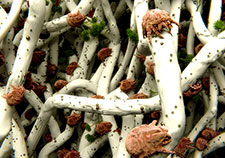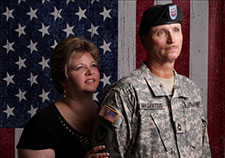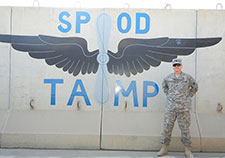Office of Research & Development |
 |
Office of Research & Development |
 |


Dr. Achsah Keegan (second from left) and colleagues Dr. Amit Golding, Molly Hritzo, and Dr. Hongjuan Gao are looking at how immune cells respond to house dust mites. The work could yield wider insight on the respiratory problems affecting many Iraq and Afghanistan Veterans. (Photo by Mitch Mirkin)
May 31, 2018
By Mitch Mirkin
VA Research Communications
For 40-year military Vet, causes of lung ailment and other health problems remain a mystery
Don’t let it disturb your sleep tonight, but in a study that got lots of press about seven years ago, British researchers found that the average pillow, after two years of use, is full of nasty microscopic stuff. At least a third of a pillow’s weight, they showed, can consist of live and dead dust mites, their droppings, human skin cells, and bacteria.
Steps to deal with dust mites can be found here. The tiny spider-like creatures don’t bite and don’t spread disease. But they can trigger allergic reactions like a stuffy or runny nose, itchy or watery eyes, and sneezing. They have also been linked to asthma.
A VA research team in Baltimore is trying to get a handle on how exactly dust mites affect the immune system and set off respiratory problems. The study won’t show the extent to which dust mites may have affected troops, but it may lead to solutions to help them going forward.
Past research, such as a 2010 study led by Dr. Anthony Szema, then with the Northport VA Medical Center in Long Island, suggested that dust mites could be one of several possible triggers—along with other indoor and outdoor risk factors—to help explain new-onset asthma among Iraq and Afghanistan Veterans.
Lead researcher on the new Baltimore study is Dr. Achsah Keegan, a PhD scientist who specializes in immunology and microbiology. Her lab buys lab-grown house dust mites that are ground into a powder. The scientists compare that with environmental dust samples, collected by Army researchers with special air samplers, from Camp Victory in Iraq and from a U.S. site with a somewhat similar climate: Fort Irwin, in the Mojave Desert in California.
Keegan’s main goal is to see how the various substances affect immune cells called macrophages, isolated from mice or from human blood samples.

The illustration is based on a microscopic image of dust mites inside a pillow. (Photo: ©iStock/selvanegra)
She already knows that proteins on the cells’ surface called “pattern recognition receptors” get activated. This could lead to chronic inflammatory diseases, including asthma. Keegan’s team is digging deeper, looking at additional chemical pathways, for more clues that might lead to new treatments.
The Baltimore group is also working with mice in the lab to see how their lungs respond when exposed to dust and specifically to mites. That will shed further light on how humans are affected.
Keegan explains the rationale for the research in a nutshell: “What’s clear is that these troops [those deployed recently to Iraq or Afghanistan, or to the Persian Gulf in the early 1990s] have come home with higher rates of asthma and other respiratory problems,” compared to non-deployed troops, or those deployed to other regions. “The question is why. One theory is that they’ve been exposed to a much higher level of inhaled particulates.”
Researchers with VA, the Department of Defense, and other agencies have paid special attention to certain sources of particulates, such as burn pits. There’s also the sand that gets ferociously blown around in desert storms. VA’s Office of Public Health maintains a website with more information on these and other military exposures.
Dust mites may be an overlooked factor. Keegan explains that we all breathe in dust-mite-related debris, but she says the threat might be worse for deployed troops. Szema and colleagues, in their 2010 article, had written, “Conditions faced by soldiers are unprecedented because they live in confined spaces (trailers) unless on patrol.” One factor is that their sleeping bags might go months without being laundered and be a haven for mites.
Keegan notes that “inhaled particulates include dust. And dust, everywhere, contains house dust mite debris: dead mites, their fecal products, human skin, bacteria, and fungi. When you dust your furniture, you’re dusting up dead skin [which is what mites eat], full of dead dust mites with their feces, their bacteria, and fungal spores. It’s a hodgepodge, and you’re breathing that every day. Over time, your mattress and pillows accumulate this stuff.”

Molly Hritzo is part of Dr. Achsah Keegan's team. Here, she checks flow cytometry results to understand how immune cells called macrophages react to house dust mites. (Photo by Mitch Mirkin)
Even the microbiologist, used to looking at pathogens and tiny critters of all types in the lab, says “it’s ghastly.”
So we’re all exposed to this yucky microscopic mix in the air. But soldiers on deployment might get a heavier dose.
Keegan adds that “when they’re in the battle zone, the particulates could be more complex: burn pits, diesel, sand—all sorts of things. The point of the research is to try and understand how these environmental exposures are leading to asthma and other allergic manifestations.
“The numbers are there,” she says, referring to the epidemiologic studies that show high rates of lung problems in Iraq and Afghanistan Veterans. “The mechanism, however, is unknown. That’s the question mark.”
She says her project, funded by VA’s Biological Research and Development Service, is “starting simple,” with one species of dust mite—there are more than a dozen overall—and the dust samples from Iraq and stateside.
“We want to understand the signaling,” says Keegan. “What does the preparation [of dust mites] do to cells in the lung to cause them to respond? We’ve identified some of these pathways, and they can be inhibited by drugs. So there is there potential to develop treatments.”
The equipment she uses, in a core facility that is shared by several research teams at the Baltimore VA, can look at one cell in detail, or thousands of them together. They show up as red or green blobs on a computer screen, with detailed reports about their shape, movement, and other factors.
"The numbers are there. The mechanism, however, is unknown. That's the question mark."
“We’re putting house dust mites onto a population of macrophages that are adhered to a plate. Each cell doesn’t respond identically. You can look at each individual cell, but then you can also look at 10,000 different cells, so you have the statistical power.”
The team looks at what genes get activated, and how this affects the levels of different proteins. They also look at morphology—the cells’ shape and structure—and their migration patterns. Macrophages move within an organism to zero in on foreign invaders and other threats.
Some of the mice involved in the research have been genetically engineered. “We have mice that are lacking some of these innate sensing pathways [part of the immune system] that we’re interested in,” says Keegan. The so-called “knockout mice” can help the scientists better understand the role of certain molecules.
For comparison, the team also uses a lab preparation of cockroaches—another potent allergen. Whether the bugs have been an allergic factor in Mideast war zones is unknown. But scientists do know they are an allergic threat to inner-city kids.
What’s interesting, says Keegan, is the similarity among the various allergens, in terms of how they affect the macrophages. That may give her results wide relevance.
“At least so far what we’re seeing is that the same pathways are activated whether we use house dust mites, cockroaches, Iraq dust, or California dust. So the pathways we’re identifying using our house dust mites as the model may also be relevant to pathways that are activated by, say, sand that is covered with cockroach, or sand covered with diesel particles.”
She does point out that Iraq dust overall appears to be up to eight times more potent than California dust or the dust mite preparation in terms of kicking up certain immune responses.
Keegan hopes the work will add to researchers’ overall understanding of what is driving the respiratory symptoms of some Iraq and Afghanistan Veterans, whether it’s asthma, rhinitis, or constrictive bronchiolitis, a condition in which the small airways in the lungs are inflamed and narrowed, resulting in shortness of breath.
Just how long those problems will persist for the Vets affected remains an open question.
Despite a few studies on the issue by VA and DoD researchers, “we don’t have a good sense of the overall prevalence or trajectory of the problems,” notes Dr. Drew Helmer, director of the War Related Illness and Injury Study Center at the VA New Jersey Health Care System.
His colleague Dr. Michael Falvo agrees that “there is an absence of longitudinal data.” On the eve of his attending the recent American Thoracic Society annual meeting, held May 18 – 23 in San Diego, he said he expected researchers there to bring up the question and discuss related data from the Millennium Cohort Study.
Also, he said a recently launched VA Cooperative Studies Program trial known as Service and Health Among Deployed Veterans, or SHADE, may eventually help fill in some gaps. The study is using NASA satellite data and other sources to trace Veterans’ exposures to dust storms and pollution, in an effort to better understand what drove their pulmonary problems.
A few years ago, Cheryl Masevicius took a large sheet of yellow tag board and penciled in several puzzle shapes. In each, she wrote one of the health problems her husband, Rob, had been experiencing since he returned from Iraq in 2007. Among them were coughing and shortness of breath, rashes, and an irritable gut.
She cut out the pieces, took them down to the Baltimore VA Medical Center, and laid them out on the tables of the doctors who would be seeing her husband.
“Here are the pieces to the puzzle,” she told the doctors. “Could you please put them together.”
Today, the puzzle remains unsolved.
“I’ve had many doctors take photographs of that,” says Cheryl. “But I still have the puzzle pieces, and I still have my husband continually getting worse.”
Rob Masevicius, today 59, served 40 years in total, between the Maryland National Guard and active-duty Army. He retired as a first sergeant under the 29th Combat Aviation Brigade. On the civilian side he retired from the Army aviation support facility at Aberdeen.

Cheryl and Rob Masevicius posed for this military portrait in 2010. (Photo by Ian Furlong Photography)
He and Cheryl trace the origins of his respiratory illness to what soldiers have termed, not so affectionately, the “Kuwaiti crud”—a lung infection brought on by breathing in fine particles of desert dust. Rob and thousands of other U.S. troops spent time in Kuwait before moving into Iraq, and many were afflicted with what a 2004 Stars and Stripes article described as “a sand-induced case of bronchitis that can turn nights into a hacking hell.”
For most, the infection and the cough eventually cleared up. Not so for Rob.
“For him, it never went away,” says Cheryl. “He’s continued with the cough ever since. And it’s progressively gotten worse.”
Rob’s pulmonologist, Dr. Stella Hines, with the Baltimore VA and the University of Maryland, says he has “probable constrictive bronchiolitis, due to exposures sustained during military service.”
There’s a long list of possible wartime exposures that the Maseviciuses suspect may have worsened Rob’s lung condition, and possibly caused some of his other ailments: sandstorms, burn pits, oil refineries, cement factories, maybe even toxins from chemical weapons that lingered in the sand and got blown around in storms.

Rob Masevicius stands in front of a steel-reinforced concrete blast wall at a Theater Aviation Maintenance Program facility at a seaport of debarkation in Kuwait in 2010.
“Is it specifically just burn pits? We don’t know,” says Cheryl. “We just know there were many toxins they were exposed to. I sent a perfectly healthy, vibrant man who was on no medications over there, and through the deployments. [After the Iraq deployment in 2007, Rob went again to Kuwait in 2010.] And look at where we are now.”
Cheryl is involved with the organization Burn Pits 360, which has been invited to submit testimony for a June 7 congressional hearing on the matter.
She is committed to doing what she can to help her husband, but the frustration has been mounting.
Treatment-wise, not much has helped. Rob gets some relief when he does deep breathing exercises with a device called a spirometer, designed to help open the air sacs in the lungs.
But at this point, even walking up the 13 stairs in their modest Halethorpe, Maryland, home is a challenge.
The couple set up a small makeshift baseball field in the backyard for the four-year-old of a close friend, whom they have helped raise since he was an infant. A few minutes of light ball-playing is enough to tire Rob.
“Just trying to play with him, my husband gets extremely winded,” says Cheryl. “We’re not talking about a lot of playing. Just trying to tag him out at the bases. My husband will throw the ball to me, I’ll throw it back, and here’s the little one trying to run. And my husband has to sit down after that.”
Cheryl and Rob don’t know if the mystery will ever be solved. They are just hoping and praying for a decent quality of life for Rob in the years ahead—along with benefits and specialized medical care.
“My husband is a wonderful human being,” says Cheryl. “He served his country with pride and honor and dignity. He’s sick, and this is the only life he has. It would be nice to have answers.”
VA Research Currents archives || Sign up for VA Research updates